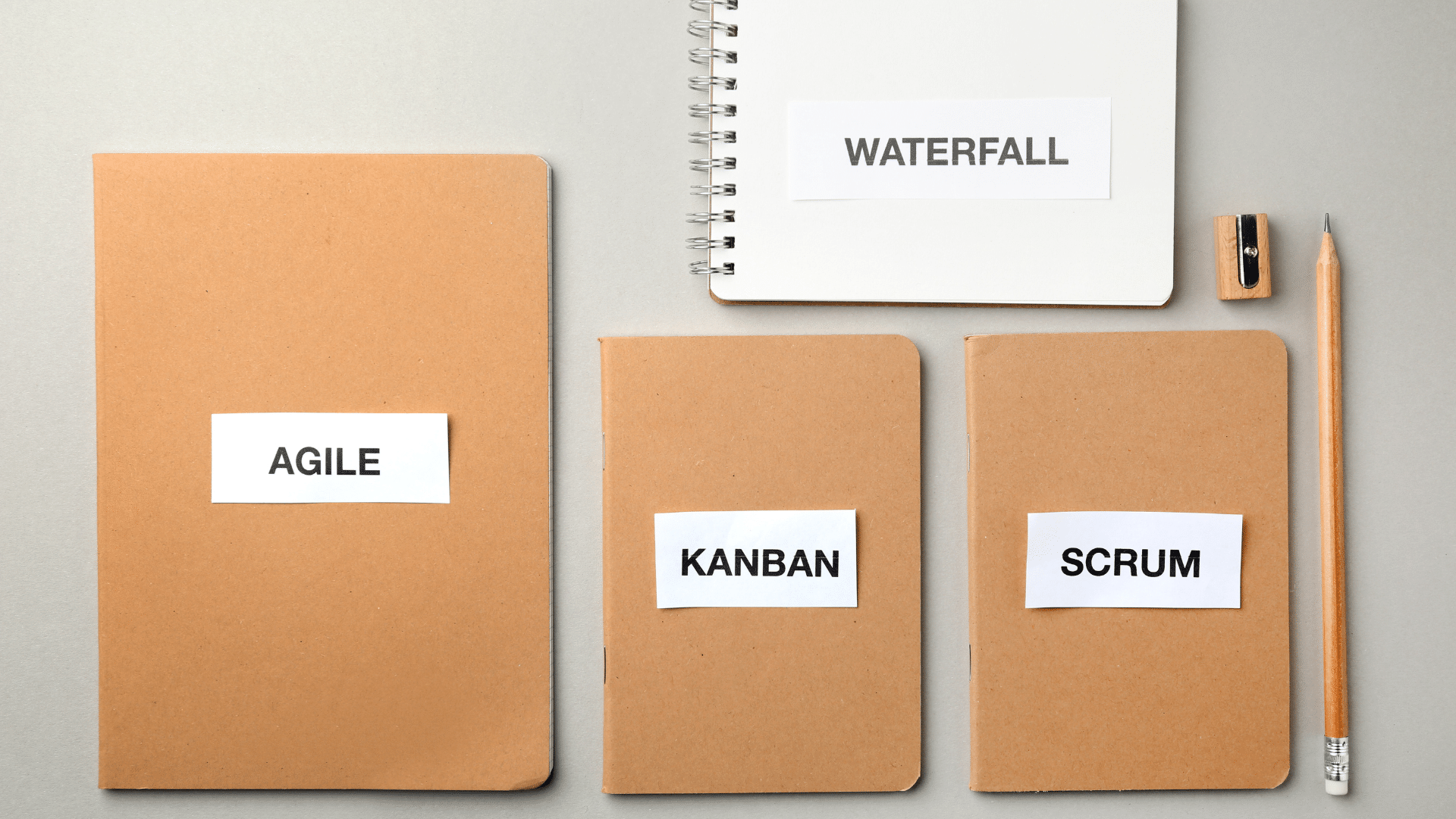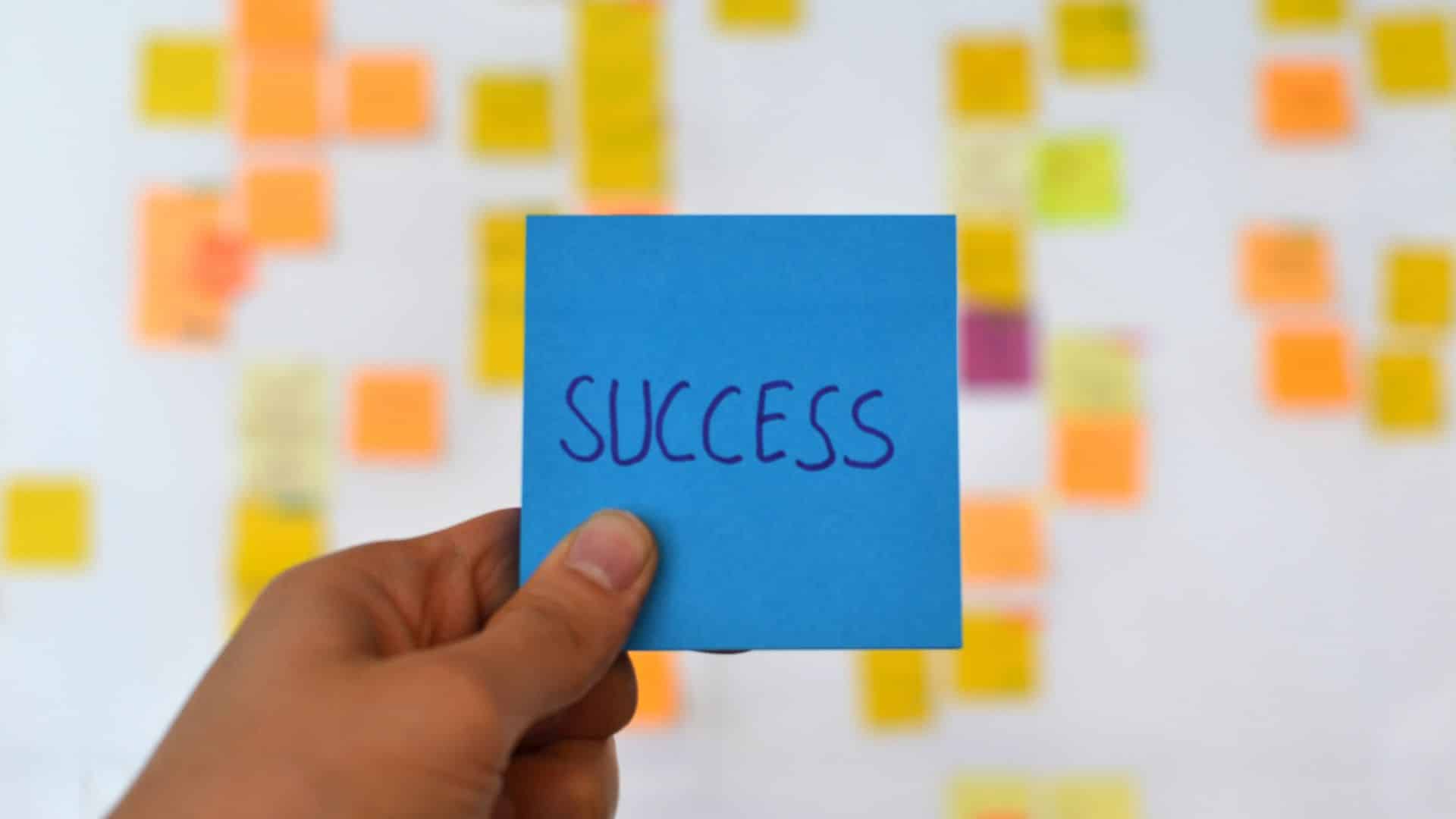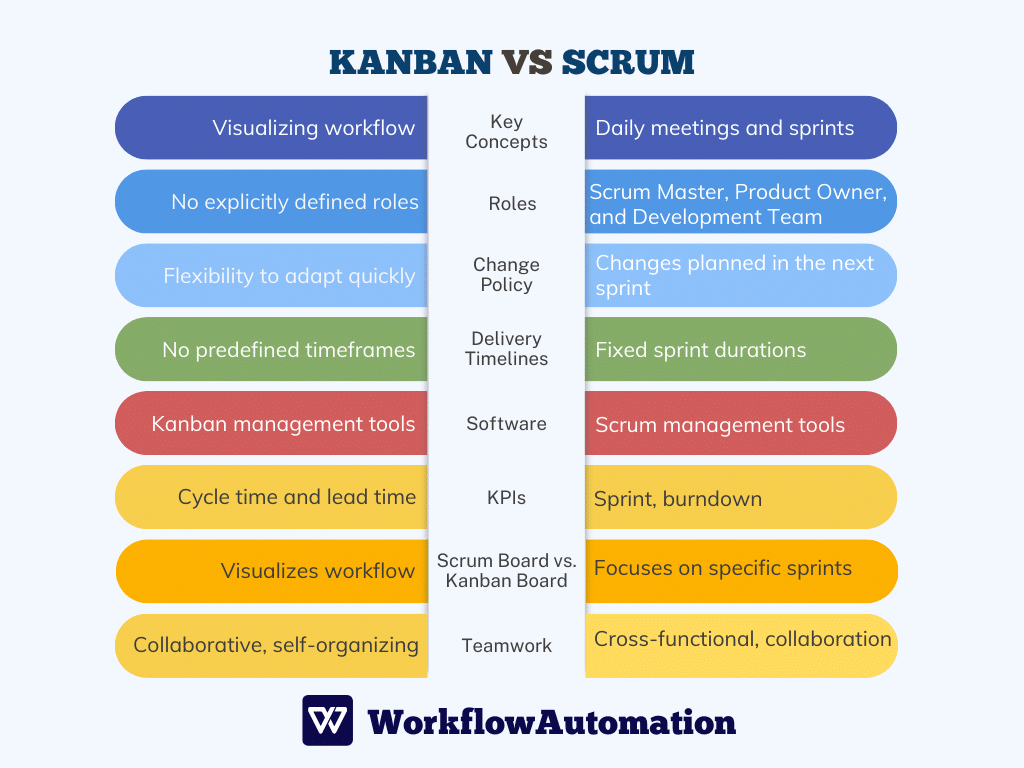When choosing an agile methodology over traditional project management approaches, the “Kanban vs. Scrum” discussion often arises. Both Kanban and Scrum are popular modified approaches within the Agile methodology.
Generally, Agile methodology is based on an iterative process, which involves completing tasks in short sprints, receiving feedback from stakeholders, and making adjustments until the project is complete.
In this text, we will explore the reasons for selecting Kanban or Scrum and their respective advantages and disadvantages.
What is Kanban?
A Kanban is essentially a tool for project management designed to help visualize work, limit the amount of work that is currently in progress, and maximize efficiency.
Let’s paint a quick picture.
Imagine a board divided into three columns. The first column contains TO-DO cards that represent tasks to be assigned to employees. The middle column contains DOING cards, showing which tasks are in progress and at which stage. The last column contains DONE cards, indicating the completed tasks.
The person in front of this board has a visual overview of all functions in preparation, jobs in progress, and completed tasks. This visualization is the key that unlocks the door to optimization, fostering teamwork, collaboration with customers or suppliers, and flexibility in task execution.
It is assumed that each of the three mentioned columns has a limit, indicating how many cards can be in the same column at any given time. The key is to allow a natural workflow, with tasks in progress needing to be finished and moved to the DONE column before the next job can emerge. That prevents bottlenecks in the workflow.
For the Kanban framework to work effectively, all team members must understand the meaning of the cards in each column and the constraints involved. What the team members see on the board should encourage them to take real action.
Therefore, if there are indications of bottlenecks forming, it is necessary to take action to prevent them. Rely on feedback to understand what the workflow requires to be optimized, ultimately leading to the full expression of the team’s potential.
History of the Methodology
Back in 1940, while analyzing production, consuming and storing raw materials, and communicating with suppliers, the Japanese giant Toyota realized a considerable potential for optimizing their production process.
Even without delving into a detailed analysis of how the Kanban methodology contributed to Toyota’s success, it is easy to see how they still thrive in the market even 80 years after implementing this method.
With the development of the IT industry and software engineering, Kanban, as part of the agile methodology, found its way and brought a lot of value to projects in diverse industries.
What is Scrum?
Scrum represents an agile methodology model based on the mechanism of continuous progress through the application of various models that enhance collaboration within the team, transparency of roles and responsibilities, and the demand for feedback.
The fundamental essence of Scrum is building open and honest relationships within the team—relationships grounded in respect and trust.
Scrum is a term from the sports sphere. It represents a moment where rugby players gather to collectively try and advance in the attack. This moment of teamwork and collaboration serves as the inspiration for the Scrum methodology.
This methodology involves working in iterations of approximately 30 days, which include daily brief meetings to assess the work done, the tasks to do, what impediments exist in executing tasks, and how to overcome those obstacles to achieve better performance.
As implied by this methodology, working in sprints allows continuous monitoring of team progress and employee performance and supports better results by completing specific tasks within shorter intervals.
Scrum teams consist of the Product Owner, the Scrum Master, and the Development Team.
The Product Owner acts as a bridge between stakeholders, their requirements and needs, and the company’s vision and capabilities. The Scrum master guides the team, ensuring that work functions according to Scrum principles and evolves smoothly. The Development Team, typically composed of experts from different fields, is responsible for product development.
Kanban vs. Scrum: Major Differences
Kanban and Scrum are two popular methodologies, often compared in the context of Kanban vs. Scrum, aiming to improve productivity, efficiency, and continuous improvement. However, their approaches to project management entail different principles and methods.
Below, we outline Kanban vs. Scrum differences in various management aspects to comprehensively understand these two business approaches and help you identify the one that suits your organization best.
#1. Key Concepts
Kanban: The critical concept of Kanban is a visual approach that facilitates easy workflow tracking and ensures a constant flow. It involves dividing the workflow into three segments: “to-do,” “in progress,” and “done.” By using cards or sticky notes, you can monitor the completion of each phase and the transition to the next.
Scrum: In Scrum, the organization revolves around daily meetings and sprints. Daily meetings inform team members about completed and planned tasks for the day and address any identified work issues.
Scrum sprints are generally short, lasting from one week to a month. Using sprints facilitates project management because it is easier to monitor the execution and performance of completed tasks. The goal is to analyze the monthly results and improve performance in each subsequent sprint.
#2. Roles
Kanban: Kanban is much more flexible when assigning roles within the team than Scrum. In Kanban, there are no explicitly defined roles. Instead, it allows team members to organize themselves and collaborate, emphasizing the collective responsibility of the entire team for their work rather than individual accountability.
Scrum: Roles in Scrum are clearly defined. There are three leading roles: Scrum Master, Product Owner, and Development Team. Each position carries specific responsibilities.
The Scrum Master ensures that the team operates according to Scrum principles and facilitates progress. The Product Owner deals with prioritizing the work within the project and collaborating with stakeholders. The Development Team consists of experts who aim to deliver the project.
#3. Change Policy
Kanban: The ability to quickly respond to changes is another difference compared to the Scrum methodology, which Kanban enables by not having predefined delivery deadlines. Kanban helps with more straightforward adaptation to emerging changes by forming deadlines based on needs, allowing flexibility to pause a task on the cards and replace it with another.
Scrum: In the Scrum methodology, planning activities for the sprint takes place in advance. Typically, the Scrum team plans activities for the upcoming sprint to accommodate new requirements. Therefore, interrupting planned activities during a sprint can disrupt the workflow, which is why there is a need to wait for the next iteration.
#4. Delivery Timelines
Kanban. The difference between the Kanban method and Scrum regarding delivery timelines lies in the fundamental approach. Kanban focuses on maintaining a continuous workflow without interruptions, where the volume of work depends on capacity rather than predefined periods.
By controlling and measuring the time from starting a specific task to its completion, the Kanban system aims to achieve better results in shorter time frames.
Scrum. In Scrum, specific delivery timelines involve creating sprints lasting a maximum of one month, but these could be as short as one week or extended to two or three weeks. A particular volume of work is planned within the defined time frame, enabling clear visibility of when each delivery will occur.
#5. Software
Kanban. Kanban software encompasses project management tools used to manage Kanban boards for tracking the execution of work tasks. Due to its focus on team success, Kanban software is centralized, allowing the team to collaborate and work together by providing options to assign tasks, set deadlines for their completion, and monitor the workflow process.
Scrum. With its distinct foundation from Kanban, Scrum software enables the formation of sprints. The quantity of work that can be processed determines the goal of the sprint—the amount of work to achieve by the end of a sprint.
The scrum software tracks both individual and teamwork.
#6. KPIs
Kanban. KPIs (Key Performance Indicators) measure the efficiency of task execution. Since Kanban does not rely on sprints, the methodology evaluates the time to complete tasks and the quantity achieved. Data on time and amount of work help improve work processes and make them more efficient.
Scrum. In Scrum, performance is measured over a more extended period, precisely how much the team has accomplished within a sprint. During sprint planning, the team estimates the amount of work they need to complete, and based on the planned and finished work, the performance of team members is measured. This evaluation helps identify obstacles and determine how to address them.
#7. Scrum Board vs. Kanban Board
When deciding between Kanban and Scrum boards, the main focus is tracking the workflow and comparing planned work with completed work on the respective Kanban and Scrum boards.
Kanban. For Kanban methodology, the flow of work is essential, which is why a limited amount of work is allowed in each stage (“To Do,” “Doing,” and “Done”).
Scrum. In Scrum, the main focus is on the sprints. This involves tracking the execution of tasks during a single sprint and identifying any delays or issues for the next sprint. In Scrum, the stages on the board are simple and clear: “To Do,” “In Progress,” and “Done.” The board provides transparency by displaying all tasks` due dates during the sprint.
#8. Teamwork
Kanban. The Kanban methodology provides greater flexibility and freedom in organizing teamwork. At the center of Kanban methodology is collective responsibility, where the key is for the entire team to collaborate and be aware of their duties.
The team autonomously organizes itself to execute work tasks and makes decisions regarding task allocation and progress. The group collaborates, making decisions, assigning tasks, and progressing together.
Scrum. Scrum teams have clearly defined roles within them. Typically, teams consist of individuals with specific responsibilities, and collectively, they work towards delivering a particular product.
While each individual has their own role and responsibility, establishing good teamwork and fostering open and honest communication are essential to achieving the desired quality and quantity at the end of each sprint.
Kanban vs. Scrum differences
Kanban vs. Agile
As we have already mentioned at the beginning of the text, Kanban and Scrum are two frameworks through which the principles and practices of agile methodology are implemented.
As the overarching concept, agile methods aim to improve collaboration among team members and increase efficiency through iterative processes within a specific time frame. Specifically, the Agile methodology is based on a structured approach with fixed iterations and roles, which leads to accelerated project execution.
On the other hand, Kanban is a visual approach to improving the process. Unlike agile methodology and other frameworks within it, Kanban is more focused on speed and an iterative approach.
Kanban is also more systematic in identifying bottlenecks, aligning with its primary function. However, one criticism of Kanban as an approach is that team members must have precisely defined roles, which can sometimes lead to chaos.
Nevertheless, there are still significant reasons why this methodology is widely applied, and it is essential to understand that Kanban contributes to high-quality work as an agile methodology tool.
Kanban vs. Waterfall
The waterfall methodology, unlike the agile methodologies of Kanban and Scrum, follows a linear project management approach.
Due to its policy that prohibits moving to the next phase until the previous one is completed, the waterfall methodology offers a clear and visible end goal with a predictable path toward achieving it and what needs to be accomplished along that path. That way, team members know and anticipate the terrain they will need to navigate.
This can affect the ability to change and adapt quickly, which can be considered a weakness of this approach. It can also be categorized by weaker communication and feedback loops with the client and other external stakeholders.
On the other hand, Kanban is much more adaptable to changing circumstances, providing greater flexibility for the team. However, this enhanced adaptability can also present a potential disadvantage, as it can lead to confusion about task phases and difficulties in determining their priorities.
Additionally, team meetings, stakeholder suggestions, and partner involvement in Kanban can lead to obstacles in implementing this approach.
When to Choose Kanban?
Kanban is suitable for teams whose goal is to improve the project process. As we mentioned, the visual approach to process improvement allows the team to reduce tasks that are in progress and bring them to completion, allowing new tasks to find their place on the board.
That makes identifying bottlenecks in the process easier, ultimately contributing to efficiency and optimization. Kanban does not practice strict role division within the team, nor does it rely on interdependent collaboration.
Therefore, when choosing between Kanban vs. Scrum, consider Kanban for smaller, specialized groups.
When to Choose Scrum?
The application of the Scrum framework is better for larger teams with broader end goals focused on meeting wide-ranging needs. That is because Scrum involves a clear division of roles among team members, which is beneficial for groups whose work overlaps, ensuring everyone knows their tasks.
Furthermore, this role clarity makes it easier to replace a team member if needed, as they would already be familiar with Scrum’s functionality.
With Scrum, the project can be effectively broken down into several components or milestones, facilitating the implementation of sprints and ensuring alignment across different team segments within the context of Kanban vs. Scrum.
Scrum allows changes to be incorporated only after the completion of a sprint, not before. Additionally, scrum pays significant attention to stakeholder feedback, demonstrating that it is a framework suitable for larger teams.
Conclusion
Having explored the rundown of Kanban vs. Scrum frameworks and their advantages and disadvantages, you now possess valuable insights to decide which suits you better.
The choice between these Agile methodologies hinges on project estimation, the team working on its implementation, and the specific tasks at hand. Additionally, remember that you can consider a hybrid approach by combining the best aspects of both, which is known as “Scrumban.”
Kanban vs Scrum FAQ
#1. Which is better, Kanban or Scrum?
Both frameworks are tailored to specific teams, projects, and goals, so it can’t be said which one is better overall. The choice between Kanban vs. Scrum depends on each project`s unique requirements and characteristics and the team`s preferences and needs.
#2. Is Kanban Scrum?
Kanban and Scrum are different. There are essential differences between them, which we have explained in the text.
#3. Are Kanban and Scrum a part of Agile?
Yes, Kanban and Scrum are frameworks that embody the agile methodology and are based on its principles.







